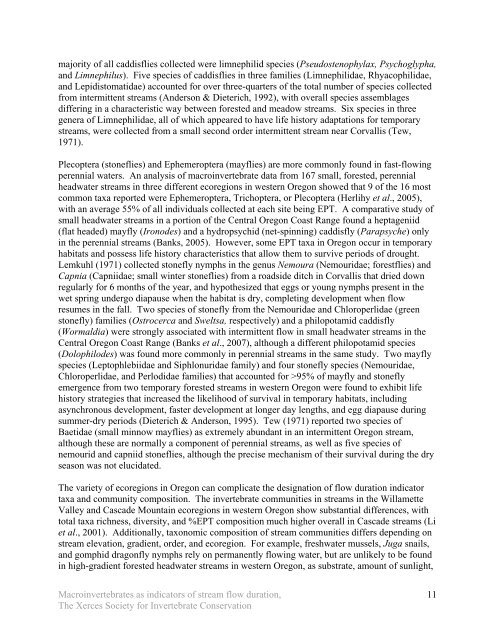Using Aquatic Macroinvertebrates as Indicators of Stream Flow ...
Using Aquatic Macroinvertebrates as Indicators of Stream Flow ...
Using Aquatic Macroinvertebrates as Indicators of Stream Flow ...
Create successful ePaper yourself
Turn your PDF publications into a flip-book with our unique Google optimized e-Paper software.
majority <strong>of</strong> all caddisflies collected were limnephilid species (Pseudostenophylax, Psychoglypha,and Limnephilus). Five species <strong>of</strong> caddisflies in three families (Limnephilidae, Rhyacophilidae,and Lepidistomatidae) accounted for over three-quarters <strong>of</strong> the total number <strong>of</strong> species collectedfrom intermittent streams (Anderson & Dieterich, 1992), with overall species <strong>as</strong>semblagesdiffering in a characteristic way between forested and meadow streams. Six species in threegenera <strong>of</strong> Limnephilidae, all <strong>of</strong> which appeared to have life history adaptations for temporarystreams, were collected from a small second order intermittent stream near Corvallis (Tew,1971).Plecoptera (stoneflies) and Ephemeroptera (mayflies) are more commonly found in f<strong>as</strong>t-flowingperennial waters. An analysis <strong>of</strong> macroinvertebrate data from 167 small, forested, perennialheadwater streams in three different ecoregions in western Oregon showed that 9 <strong>of</strong> the 16 mostcommon taxa reported were Ephemeroptera, Trichoptera, or Plecoptera (Herlihy et al., 2005),with an average 55% <strong>of</strong> all individuals collected at each site being EPT. A comparative study <strong>of</strong>small headwater streams in a portion <strong>of</strong> the Central Oregon Co<strong>as</strong>t Range found a heptageniid(flat headed) mayfly (Ironodes) and a hydropsychid (net-spinning) caddisfly (Parapsyche) onlyin the perennial streams (Banks, 2005). However, some EPT taxa in Oregon occur in temporaryhabitats and possess life history characteristics that allow them to survive periods <strong>of</strong> drought.Lemkuhl (1971) collected stonefly nymphs in the genus Nemoura (Nemouridae; forestflies) andCapnia (Capniidae; small winter stoneflies) from a roadside ditch in Corvallis that dried downregularly for 6 months <strong>of</strong> the year, and hypothesized that eggs or young nymphs present in thewet spring undergo diapause when the habitat is dry, completing development when flowresumes in the fall. Two species <strong>of</strong> stonefly from the Nemouridae and Chloroperlidae (greenstonefly) families (Ostrocerca and Sweltsa, respectively) and a philopotamid caddisfly(Wormaldia) were strongly <strong>as</strong>sociated with intermittent flow in small headwater streams in theCentral Oregon Co<strong>as</strong>t Range (Banks et al., 2007), although a different philopotamid species(Dolophilodes) w<strong>as</strong> found more commonly in perennial streams in the same study. Two mayflyspecies (Leptophlebiidae and Siphlonuridae family) and four stonefly species (Nemouridae,Chloroperlidae, and Perlodidae families) that accounted for >95% <strong>of</strong> mayfly and stoneflyemergence from two temporary forested streams in western Oregon were found to exhibit lifehistory strategies that incre<strong>as</strong>ed the likelihood <strong>of</strong> survival in temporary habitats, including<strong>as</strong>ynchronous development, f<strong>as</strong>ter development at longer day lengths, and egg diapause duringsummer-dry periods (Dieterich & Anderson, 1995). Tew (1971) reported two species <strong>of</strong>Baetidae (small minnow mayflies) <strong>as</strong> extremely abundant in an intermittent Oregon stream,although these are normally a component <strong>of</strong> perennial streams, <strong>as</strong> well <strong>as</strong> five species <strong>of</strong>nemourid and capniid stoneflies, although the precise mechanism <strong>of</strong> their survival during the dryse<strong>as</strong>on w<strong>as</strong> not elucidated.The variety <strong>of</strong> ecoregions in Oregon can complicate the designation <strong>of</strong> flow duration indicatortaxa and community composition. The invertebrate communities in streams in the WillametteValley and C<strong>as</strong>cade Mountain ecoregions in western Oregon show substantial differences, withtotal taxa richness, diversity, and %EPT composition much higher overall in C<strong>as</strong>cade streams (Liet al., 2001). Additionally, taxonomic composition <strong>of</strong> stream communities differs depending onstream elevation, gradient, order, and ecoregion. For example, freshwater mussels, Juga snails,and gomphid dragonfly nymphs rely on permanently flowing water, but are unlikely to be foundin high-gradient forested headwater streams in western Oregon, <strong>as</strong> substrate, amount <strong>of</strong> sunlight,<strong>Macroinvertebrates</strong> <strong>as</strong> indicators <strong>of</strong> stream flow duration,The Xerces Society for Invertebrate Conservation11
















